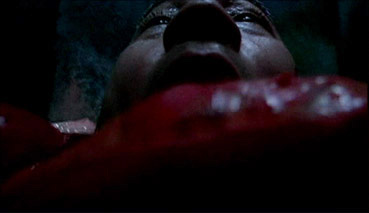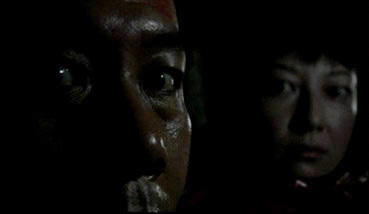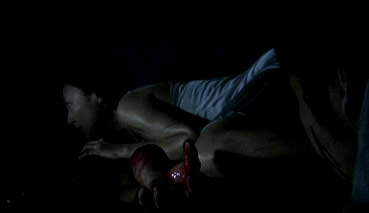|
Try
to imagine what would happen if Tsukamoto Shinya, the fiercely
individualistic director of such works as Tetsuo,
Tokyo Fist
and Bullet
Ballet, took James Wan's Saw
and Vincenzo Natali's Cube, threw out the
plots of both and ran down his own very specific thematic
path with the result. If you think you can then you might, just might, have a
flavour of how Haze plays out. But only
a flavour.
Director
Tsukamoto, who seems to almost enjoy seeing himself abused
on screen, plays an unnamed man who wakes to find himself
in a tightly confined, concrete-walled space with no idea
how he got there. Sudden he is dragged backwards by an unseen
force, cutting his head on a sharp spike as he does so.
Coming to rest in the dark of his surroundings, he discovers
that he has a serious puncture wound in his stomach and tries to comprehend where he is and how he got there. Unwilling to just lay
down and die, he begins crawling along the narrow space
ahead of him, avoiding potentially fatal injury from sharpened
spikes and a hammer that flies out of the wall. Eventually
he stumbles upon a mass of dismembered human limbs, but
lying amongst them is a girl (Fujii Kaori, who played Tsukamoto's
rebellious wife in Tokyo Fist), alive but
also afflicted by a similar stomach wound and equally determined to escape their
deadly confinement.

A
director who has worked exclusively on film and at feature
length (the exception being his contribution to the multi-story,
multi-director Female/Fîmeru, also made in 2005), Tsukamoto makes two departures from the
norm with Haze, which is just 49 minutes
long and was shot on digital video. On top of that, the 49-minute
version is actually expanded from the 23-minute original,
one of three digital shorts made for the Jeonju Film Festival
in Korea (the other two were from Korea and Thailand). The
49-minute cut is known as The Long Version, and this is
the one that has been released on DVD in the UK by new label
Terra.
The
short film format lends itself to cinematic and intellectual
experimentation, precisely because it is (usually) freed
of the pressures of audience expectation and commercial
return that handcuff the majority of even independent features.
Not that this seems to have bothered Tsukamoto much in the
past – his films have almost always had strong narrative
structures, but storytelling and experimentation have often
gone hand-in-hand to sometimes thrilling effect. The
explosive hyperactivity that characterised his early works –
from the 1988 Tetsuo through to 1998's
Bullet Ballet –
was toned down in the gentler pace of more recent works
such as Gemini
and Vital,
and some have taken this as indicative of a director
who has reached middle age and is moving away from the experimental
and towards a more character-oriented approach
to cinematic storytelling. In the respect, Haze
is a handy reminder that lurking beneath this recent surface
calm, one of modern cinema's most exciting and visionary
individualists is still chomping furiously at the bit.
Like
Saw, Haze opens with its
central character regaining consciousness in a dark, decaying
location, unsure of his whereabouts or how he arrived there.
Unlike Saw, Haze
never provides any clear explanations, being less
interested in plot twists than in creating a sense of suffocating
claustrophobia and lurking evil. Where James Wan focussed on story, Tsukamoto deals almost exclusively in suggestion
and metaphor, but in the process creates the very atmosphere
of dark dread that Wan's film promised but ultimately lacked.
On
first trying to reason out what has happened, Tsukamoto's
character speculates on the possible reasons for his abduction
and imprisonment in a verbalisation of thoughts that the
film does not really need, but which does offer a window
into the fears of the character and perhaps Tsukamoto himself.
Is he there because an expected but undefined war has finally
broken out? Or has he perhaps been grabbed by a religious
cult? Most fanciful of all, he wonders if he has been imprisoned
for the amusement of 'a rich pervert', an idea he later
dismisses following his fruitless exploration of his constrictive,
maze-like surroundings. Who, he reasons, would go to such
trouble? During his exploration he experiences what could
be a hallucination or a fragmented memory, a disjointed assault
of brief images whose brightness contrasts violently with
the gloom of his surroundings and whose content is only
glimpsed but is increasingly disturbing, as physical pleasure
gives way to bodily dismemberment on a horrific scale. Is
this a vision of what lies ahead in the maze or a recollection
of some appalling deed in which he was involved? This leads
to a suggestion that this is no rich pervert's game, but
Hell itself, and one tailored to the man's own specific
terrors.

Despite
the semi-abstract elements, there is a real narrative
structure here and the story does have a conclusion, though
if you are expecting clear and straightforward answers then
you're likely to be left banging your head against the wall.
Tsukamoto paints a picture on glass then shatters and reassembles
it, but leaves key pieces on the floor and invites us to
complete the image ourselves, and it's likely that there
will be some variation of opinion as to the true meaning
or shape of the picture we ultimately help to form. Although this will re-open
the old argument about whether something is open to interpretation or just wilfully unclear,
the journey is, as ever with Tsukamoto, one that thrills
the eyes and ears and electrifies the imagination. It stands
as an object lesson in just what you can do on DV with two
actors, a limited set and 49 minutes of screen time.
It
seems almost typical of Tsukamoto, who often preferred to
shoot on 16mm rather than the standard 35mm, that for his
first digital venture he would select not high definition but the considerably cheaper domestic mini-DV format. That
said, Haze was shot on a Panasonic AG-DVX100A,
a camera capable of producing top class images with an almost
film-like look. Digital video imposes its own restrictions
on the contrast ratio and Tsukamoto has pushed things a bit
further by shooting the majority of the film in low light,
highlighting only small portions of his subject and in places
lowering the exposure to almost Lost
Highway levels. For this to work on DVD, and
for the detail in the darker areas to be clearly seen, the
transfer needs to be close to pristine. It isn't. Not by
a bloody mile. Although an NTSC to PAL conversion is inevitable
given the film's NTSC DV origins, the image has really suffered
in the process, with the blurring of fast movement (of which
there is quite a bit) and a virtual decimation of shadow
detail. The effect on the film is close to disastrous, losing
crucial information in the gloom and making some sequences
genuinely hard to follow – the spikes shown so clearly threatening
Tsukamoto's head on the DVD cover are barely visible at
all in the film itself, effectively nullifying the considerable
tension this scene is designed to generate. The picture
is framed 16:9 and anamorphically enhanced.
The
Dolby 2.0 stereo track is clear enough, but Tsukamoto's
unsettling use of sound and Chi Ishikawa's music cry out
for 5.1.
The
subtitles are clear, but not always completely accurate,
the odd 'fuck' added where there is none in the dialogue,
for instance.
Better
news here. First up we have The Making of Haze
(23:55), an informative behind-the-scenes DV featurette
that covers pretty much all stages of the production. The
low budget nature of the enterprise is clear, as is Tsukamoto's
notoriously hands-on approach to every aspect – can you imagine
Steven Spielberg helping to build and paint the sets for
his films? This is a Japanese featurette subtitled in English.
Most, though not all of the dialogue is translated, and
the subtitles occasionally sit a little messily over the
original featurette titles.

The
Interview with Director Tsukamoto Shinya
(19:36) was conducted at the Locarno International Film
Festival in Switzerland and is intercut with touristy footage
of Tsukamoto and Fujii wandering around the resort. The
sound is a bit tinny and the film extracts are even darker
than on the feature, but the content is always interesting,
from Tsukamoto's delight with the digital format (he was
able to work faster and edit on Final Cut Pro on his PowerBook)
to his revelation that the main inspiration for the film
was the scene in The Great Escape where
a claustrophobic Charles Bronson get trapped under earth
while digging an escape tunnel. Once again, not everything
is translated, one short subtitle sitting over about three
sentences of talk. This framing is 16:9 non-anamorphic,
but don't zoom in as the subtitles run into the black border
area.
Kaori
Fujii at the Locarno Film Festival (17:01)
is a continuation of the above, complete with tinny sound
and a lack of subtitles on some dialogue, including some
interesting banter between Tsukamoto and Fujii when they
visit a mountaintop church.
Trailer
1 (1:15) is the original trailer for the long
version and is anamorphic, though dark and lacking detail.
Trailer
2 (2:25) is a longer version of the above
and just as dark.
The
Tsukamoto Shinya filmography
and the Kaori Fujii filmography
are just what they claim to be.
Finally
there is a promo for one of Terra's other releases, the
nicely titled Suicide Manual: Intermediate Level.
OK,
as a diehard Tsukamoto Shinya fan I've been looking forward
to Haze since I first heard about it and
it did not disappoint, which is more than can be said for
the DVD. Great film, a good set of features, but that transfer
really buggers the film up, robbing it of detail and making
it hard to actually work out what is going on in some scenes.
It makes me want to weep. The extras are pretty good
but have also been converted from NTSC so look grubby
in places, though the content still shines through. The
package as a whole looks very much like it's been converted
over from a Japanese DVD that I have so far been unable
to track down – one with a spot-on transfer and both cuts
of the film would be worth foregoing the subtitles for.
So the film comes highly recommended, but despite the extra
features I simply can't say the same for the DVD.
The Japanese convention of surname first
has been used for all Japanese names. |